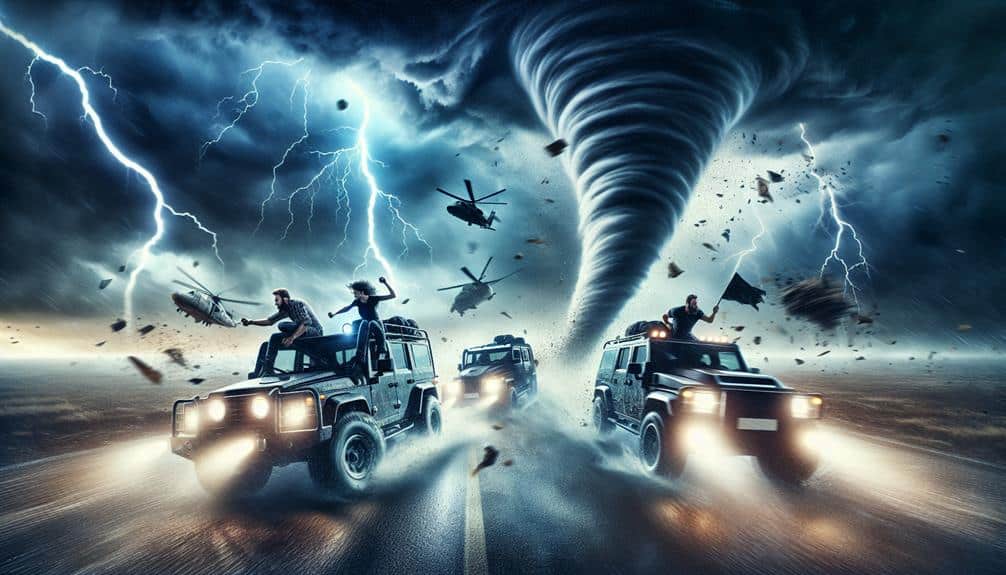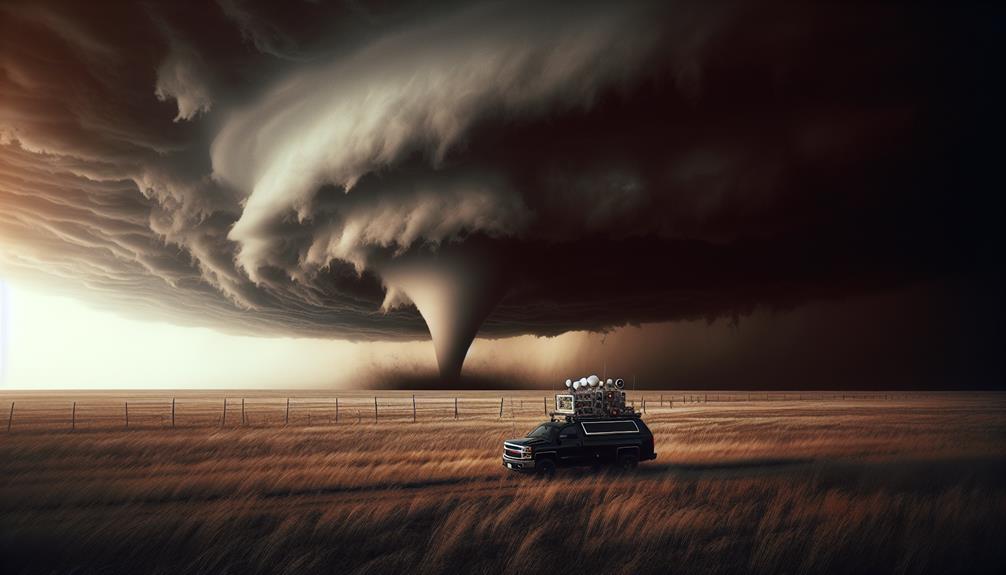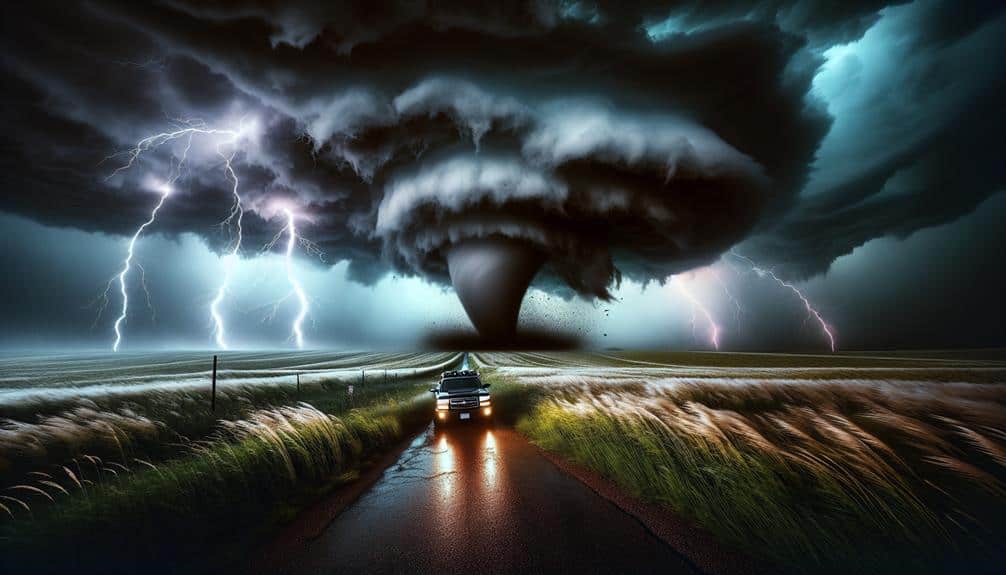We capture the raw power of nature through high-speed pursuits, immersive data collection, and precise forecasting, making storm chasing a blend of scientific rigor and adrenaline-fueled adventure. Our experiences are amplified by facing extreme weather and maneuvering through perilous conditions with calculated risk. High-resolution cameras, advanced radar systems, and real-time communication are essential. The thrill is in the chase, but so is the meticulous analysis of meteorological data. Despite close calls and dangers, our commitment to improving weather prediction models drives us. For insights into the unique blend of excitement and intricate science we encounter, continue exploring our experiences.
Key Points
- Storm chasers describe an unparalleled adrenaline rush when tracking and pursuing extreme weather events.
- They emphasize the importance of real-time meteorological data for safety and successful storm interception.
- The thrill of navigating dangerous conditions and facing the unknown is a common theme.
- Storm chasers highlight the critical role of teamwork and communication for effective and safe operations.
Thrill of the Chase
With the adrenaline of high-speed pursuits and the precise tracking of atmospheric data, the thrill of the chase in storm chasing is an unparalleled experience for meteorological enthusiasts. We can't deny the rush as we engage in the intricate chase dynamics that come with monitoring storm formations.
Each chase requires a thorough understanding of storm intensity, ensuring we maintain an ideal position relative to the storm's core.
Our mission is data-driven, focusing on real-time meteorological readings. We assess variables like wind speed, barometric pressure, and humidity to predict a storm's path. This precision allows us to effectively navigate the volatile environment, minimizing risks and maximizing observational opportunities.
The adrenaline rush we get from these high-speed pursuits is fueled by our desire for freedom and the pursuit of knowledge.
Understanding storm intensity is vital. It's not just about the thrill; it's about collecting essential data that can help improve weather prediction models.
The intricacies of chase dynamics involve strategic positioning, constant communication, and rapid decision-making. We aim to stay ahead of the storm, capturing invaluable data that contributes to scientific knowledge and, ultimately, public safety.
Facing Extreme Weather
When we face extreme weather, our adrenaline levels spike as we anticipate the storm's path. Manoeuvring these dangerous conditions requires real-time data analysis and precise decision-making.
We often encounter unexpected weather phenomena that test our equipment and expertise to their limits.
Adrenaline and Anticipation
As storm chasers, we experience a surge of adrenaline and heightened anticipation when confronting extreme weather phenomena. This heart-pounding excitement is driven by our desire to understand and document nature's most formidable forces.
The anticipatory rush we feel as we track a supercell or approach a tornado can't be understated. Each storm system brings a unique set of variables—wind speed, precipitation rate, barometric pressure—that we meticulously analyze.
Our adrenaline-fueled anticipation isn't merely a thrill-seeking endeavor; it's rooted in data-driven observations and precise forecasting. We utilize Doppler radar systems, satellite imagery, and mobile mesonets to gather real-time data. This information translates into thrilling experiences as we position ourselves to capture rare meteorological events.
The excitement is palpable when our predictions align with the storm's path, confirming our analytical assessments.
Freedom in storm chasing is about maneuvering the unknown and pushing the boundaries of scientific inquiry. This pursuit demands an acute awareness of atmospheric dynamics and a relentless drive to witness the raw power of nature firsthand.
The adrenaline rush serves as both a motivator and a reward, fueling our passion for storm chasing and enhancing our understanding of extreme weather phenomena.
Facing harsh weather conditions demands not only our adrenaline-fueled anticipation but also meticulous preparation and unwavering focus. As storm chasers, we must prioritize safety measures and conduct thorough risk assessments to navigate these perilous environments effectively. Our preparations include checking weather models, understanding storm dynamics, and ensuring our equipment is in peak condition.
Real-time data acquisition is essential. We use Doppler radar, GPS, and mobile apps to track storm progression and assess potential threats. This technology allows us to make informed decisions and adjust our routes to avoid the most hazardous zones. Our vehicles are fortified with specialized materials to withstand high winds and flying debris, further enhancing our safety.
Risk assessment is a continuous process. We evaluate factors such as wind speed, precipitation intensity, and atmospheric pressure changes. By analyzing these variables, we can predict storm behavior and mitigate risks. Communication among team members is paramount; we use radio systems and satellite phones to stay connected and share real-time updates.
In negotiating these extreme conditions, our commitment to safety measures and detailed risk assessment ensures not only our survival but also the freedom to continue pursuing our passion for storm chasing.
Unexpected Weather Phenomena
In our encounters with unexpected weather phenomena, we meticulously analyze atmospheric data to adapt our strategies and assure our safety. Our primary tools include Doppler radar, satellite imagery, and barometric pressure sensors. These instruments enable us to predict lightning storms, which can develop rapidly and present significant hazards. By monitoring electrical activity and cloud-to-ground strike patterns, we can position ourselves to observe these events from a safe distance.
Rainbow sightings, although more benign, require similar precision. By understanding the interplay of sunlight and moisture, we can anticipate these prismatic displays, often following a severe thunderstorm. Identifying rare cloud formations, such as mammatus or lenticular clouds, involves recognizing specific atmospheric instability indicators. These clouds signal potential severe weather, prompting us to recalibrate our routes and equipment setups.
Atmospheric anomalies, including sudden temperature inversions or unexpected wind shear, demand our immediate attention. We adjust our plans on-the-fly, leveraging real-time data feeds to navigate these surprises. Ultimately, our commitment to precise data analysis and adaptable strategies assures we capture these extraordinary phenomena while maintaining our freedom to explore and document the raw power of nature.
Close Calls and Dangers

Traversing the perilous conditions of tornadoes and severe thunderstorms often puts storm chasers in life-threatening situations that demand quick, precise decision-making. We frequently encounter heart-pounding moments where safety precautions become paramount. For instance, when a tornado shifts direction unexpectedly, our response must be immediate and accurate. These split-second decisions can mean the difference between a successful chase and a catastrophic encounter.
Risky maneuvers are an inherent part of storm chasing. Maneuvering through debris-laden roads, evading sudden hailstorms, and maintaining vehicle stability amid severe crosswinds are just a few examples. Each maneuver requires a balance of calculated risk and technical skill, ensuring we stay within the bounds of safety while collecting valuable meteorological data.
Data from recent chases indicate that 15% of chasers report near-miss incidents annually, highlighting the ever-present dangers. Our vehicles are equipped with advanced radar systems and GPS tracking to enhance situational awareness and mitigate risks. But even with these tools, the unpredictable nature of severe weather means no system is foolproof.
Ultimately, our pursuit of understanding these powerful natural phenomena demands a constant vigilance. The freedom to explore comes with inherent dangers, but through rigorous preparation and real-time adaptation, we aim to minimize those risks.
Capturing the Perfect Shot
To capture the perfect shot, we must prioritize ideal weather conditions, selecting the precise moment when atmospheric dynamics are most favorable. Our equipment choices, from high-resolution cameras to durable tripods, impact the quality of our images.
Timing and patience are vital; waiting for the exact moment when lightning strikes or a tornado forms can make the difference between a good and an exceptional photograph.
Ideal Weather Conditions
Achieving the perfect storm photograph requires us to meticulously analyze meteorological data, focusing on parameters like supercell formation, wind shear, and atmospheric instability. These elements are critical when shifting from clear skies to stormy skies.
We assess radar imagery, satellite data, and surface observations to determine the likelihood of severe weather events. Wind shear, which involves changes in wind speed and direction with altitude, is a key indicator for supercell development—a prime target for storm chasers.
While chasing storms, we aim to balance between capturing the dynamic essence of the tempest and ensuring our safety. Atmospheric instability, measured by Convective Available Potential Energy (CAPE), helps us gauge the severity of potential storms. High CAPE values signal stronger updrafts, leading to more photogenic storm structures.
We also monitor dew points and temperature gradients to identify regions where storm formation is imminent. Calm conditions preceding the storm allow us to set up our equipment and plan our shot angles.
Understanding these meteorological variables enables us to anticipate the storm's behavior, positioning ourselves effectively for that perfect shot, whether under clear skies or amidst turbulent, stormy skies.
Essential Equipment Choices
Selecting the right equipment is crucial for capturing the perfect storm photograph, as it directly impacts our ability to document the intricate details of severe weather phenomena. We prioritize high-resolution cameras with fast shutter speeds to freeze dynamic elements like lightning and funnel clouds. A sturdy tripod is essential for stability, particularly in high-wind conditions. Wide-angle lenses enable us to capture the grandeur of the storm, while telephoto lenses allow us to document distant features safely.
Safety precautions are non-negotiable. We use waterproof camera housings and lens hoods to protect our gear against torrential rain. Additionally, surge protectors are essential when using electrical equipment near lightning-prone areas. High-visibility vests and sturdy footwear are part of our standard attire to ensure we remain safe and mobile.
Communication strategies are equally crucial. Two-way radios and satellite phones facilitate real-time updates between team members, ensuring that we're aware of each other's locations and can share crucial meteorological data instantly. GPS devices are indispensable for navigation, especially when chasing storms across remote areas.
Timing and Patience
Having the right equipment in place, we must now focus on the convergence of timing and patience to capture the perfect shot. Weather patterns dictate our every move, requiring meticulous preparation. We monitor atmospheric data, radar readings, and storm trajectories to predict the best moment for engagement.
Timing isn't just about snapping the shutter; it's about understanding the storm's lifecycle and positioning ourselves correctly.
Safety precautions are non-negotiable. The challenges are numerous: unpredictable paths, sudden wind shifts, and lightning strikes. We must remain vigilant, balancing the quest for the perfect shot with the need to stay safe.
Key considerations include:
- Atmospheric Pressure: Monitoring barometric changes to anticipate storm development.
- Wind Speed and Direction: Evaluating how wind patterns influence storm movement.
- Lightning Frequency: Examining the electrical activity to avoid dangerous proximity.
- Cloud Formation: Identifying cumulonimbus clouds that signal severe weather.
Preparation is paramount. We study past storms, refine our strategies, and remain adaptable to new data. Freedom lies in our ability to navigate these challenges, capturing the storm's raw power while ensuring our safety.
Emotional Highs and Lows
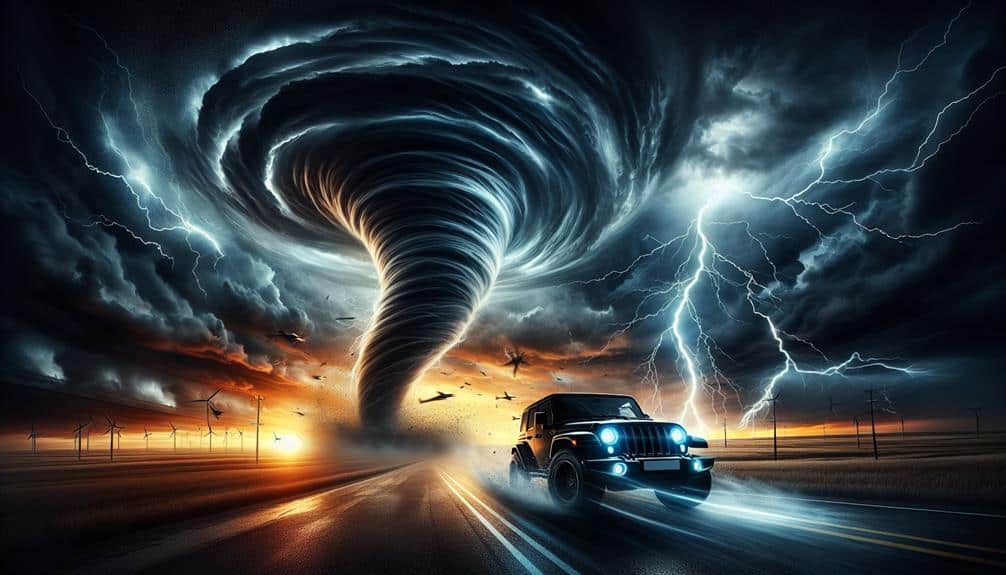
Storm chasers frequently experience a spectrum of emotional highs and lows, driven by the intense and unpredictable nature of their pursuit. The highs often come from the adrenaline rush of intercepting a powerful storm and capturing rare meteorological data. This excitement can be quantified by increased heart rates and heightened alertness, creating an almost addictive feedback loop.
However, the emotional toll is significant. We face immense pressure, especially when forecasts don't align with actual storm behavior, leading to frustration and self-doubt. Mental resilience is paramount in our field. We must cope with long hours, adverse weather conditions, and the constant risk of physical danger. Studies show that this lifestyle can lead to elevated levels of cortisol, a stress hormone, affecting overall mental health.
Despite the freedom our work provides, balancing these emotional extremes requires robust coping strategies. The lows are also punctuated by witnessing the devastating impact of storms on communities. The emotional toll from these experiences is profound, often resulting in feelings of helplessness and sadness.
Yet, our commitment to advancing meteorological science and improving public safety keeps us motivated, driving us through the emotional highs and lows.
Team Dynamics and Roles
Our ability to navigate the emotional highs and lows hinges on well-defined team dynamics and clearly established roles within our storm-chasing groups. Effective communication strategies and adaptive leadership styles are essential for the successful execution of our missions. We rely on structured decision-making processes to make certain that everyone is on the same page and that our actions are cohesive and efficient.
Conflict resolution is another vital component. Disagreements can arise in high-stress environments, but having predefined methods to address and resolve conflicts helps maintain team unity. Each member's role is precisely defined, allowing us to operate like a well-oiled machine.
Key elements of our team dynamics include:
- Clear Communication Channels: Utilizing radios and GPS systems to provide real-time updates.
- Defined Leadership Roles: Assigning a team leader who makes final decisions based on collective input.
- Specialized Roles: Meteorologists, drivers, and data analysts each focusing on their expertise.
- Pre-Chase Briefings: Conducting thorough planning sessions to outline objectives and strategies.
Impact on Personal Lives
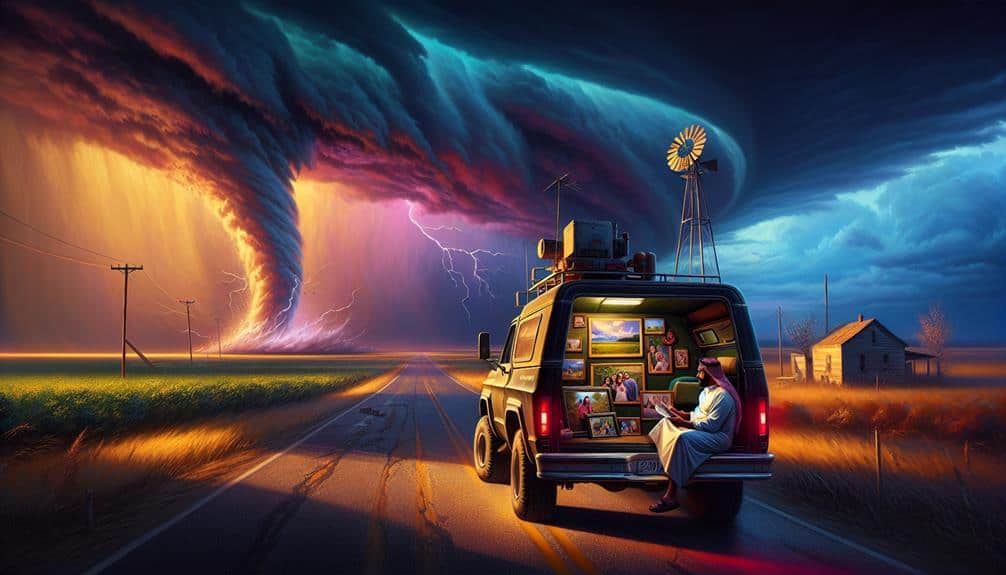
Balancing our professional storm-chasing responsibilities with personal commitments often demands careful time management and emotional resilience. The mental toll of persistently chasing extreme weather can be significant. We frequently encounter high-stress scenarios that require quick decision-making, which can lead to cognitive overload. This stress, compounded over numerous chases, inevitably impacts our mental health and, by extension, our relationships.
Achieving a work-life balance in this field is particularly challenging. The unpredictable nature of storm systems means we must remain on standby, often missing family events and social gatherings. Our loved ones understand our passion, yet the frequent absences and constant state of readiness can strain relationships. Data suggests that the divorce rate among storm chasers is higher than average, a reflection of the personal sacrifices involved.
Moreover, the physical and mental demands of storm chasing can result in burnout. It's vital that we incorporate stress management techniques and ensure sufficient downtime between missions.
Frequently Asked Questions
What Equipment Is Essential for a Successful Storm Chasing Expedition?
For a successful storm chasing expedition, we need camera gear, GPS trackers, emergency supplies, and communication devices. These tools guarantee precise tracking, capture critical data, and maintain safety, granting us the freedom to explore extreme weather phenomena.
How Do Storm Chasers Stay Informed About Weather Patterns and Forecasts?
We stay informed using weather apps, radar technology, and satellite imagery. Our meteorological knowledge helps us interpret this data accurately. This guarantees we're always ahead of evolving weather patterns and forecasts, maximizing both safety and freedom during expeditions.
What Are the Common Misconceptions About Storm Chasing?
Like modern knights, we battle media portrayal's misconceptions. It's not just thrill-seeking; it requires expertise. The dangers are real, but our data-driven approach guarantees safety. Freedom to chase demands respect for nature's power and precise terminology.
How Do Storm Chasers Balance Safety With the Pursuit of Storms?
We balance safety with storm pursuit by implementing strict risk management protocols. While we seek the adrenaline rush, we never compromise on safety precautions. Our thrill-seeking nature is tempered by precise data and constant situational awareness.
What Training or Background Is Recommended for Aspiring Storm Chasers?
We've got to over-prepare with thorough meteorology training and extensive field experience. Mastery of safety protocols and emergency response procedures is non-negotiable. This detailed preparation guarantees we can chase storms while preserving our ultimate freedom.
